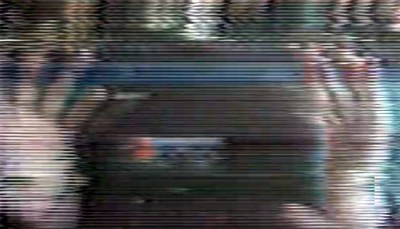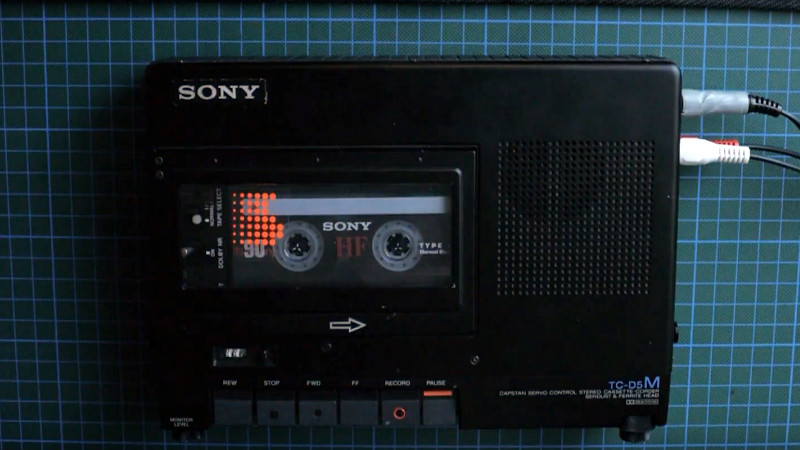A lot of projects we feature use video in some form or other, but that video is invariably digital, it exists as a stream of numbers in a computer memory or storage, and is often compressed. For some of us who grew up working with composite video there is a slight regret that we rarely get up-close and personal with an analogue stream, so [Kris Slyka]’s project putting video on a conventional audio cassette is a rare opportunity.

Readers with long memories may recall the Fisher-Price PixelVision toy from the late 1980s which recorded black-and-white video on a conventional cassette running at many times normal speed. This system does not take that tack, instead it decreases resolution and frame rate to a point at which it can be recorded at conventional cassette speeds. The result is not particularly high quality, but with luminance on one side of a stereo recording and chrominance on the other it does work.
The video below the break is a run through the system, with an explanation of how video signals work. Meanwhile the code for both encoder and decoder are available through the magic of GitHub. If you’re interested further, take a look at our examination of a video waveform.

















Ham’s have been doing this (called audio bandwidth Slow Scan TV) for more than 50 years… cassette recording and playback were often used…. monochrome and color… even from Ham satellites. Kind of reinventing the wheel… on the other hand… nah… never mind
No, slow scan TV is like using a fax machine. The fastest mode can do a picture per 18 seconds, on average it takes about a minute for a full color picture that does something like 320×240 pixels.
NBTV is what you may be aiming for – 32 lines, 12,5fps, black and white is the most used standard. https://www.taswegian.com/NBTV/forum/
Yes, while most SSTV is as you describe there are some forms of SSTV that achieve something comparable to realtime video. They just don’t fit into audio bandwidth. The Apollo 11 moonwalk was sent back using a custom system that was considered to be Slow Scan TV.
Sidenote: most of the poor quality of that footage was a result of the way the SSTV was converted to NTSC(And then again into PAL for those of us in those parts of the world) for broadcast over everyday TV. NASA did make a recording of the raw received signal… which they then lost. If we had those tapes today, we could use fancy modern Digital Signal Processing to produce a much, MUCH better version of the moonwalk.
Slow Scan TV is really cool and I’ve used it before, but it’s not really suitable for actual video which each frame taking tens of seconds to transmit. My goal was to have something that’s more in the range of 3-10 fps, which this achieves!
I have a cassette recorder on my junk parts bin and I’m tempted to try this with modern technology. I’m thinking of cramming as much data in the tape in digital format (think DAT tapes) and using a very aggressive stream compression with a modern codec. This would let me arbitrary choose a frame rate to max out that tape… hmm….
I see where you’re going, let me give you a sneak preview of your likely frame rate, two … frames per minute.
It wouldn’t be fun otherwise, right? But I don’t think it would be that bad. With QPSK or some other smart modulation on the tape, it should be possible to fit 15+ kbps in it. That should be enough for a low resolution AV1 stream
I wonder how difficult it would be to record and then play back digital 1080p video on a VHS cassette using an unmodified VCR connected to a Zynq dev board or similar.
you could call it D-VHS!
My first computer was a Texas Instruments TI-99/4A. I used a cassette recorder to store the BASIC programs I wrote on it.
I have wondered about this. What’s the maximum theoretical amount of data you can store in a cassette tape if you could use the latest and greatest modern technology? What determines this? Can we not store a lot more on there nowadays or is there something inherent in how the tape was made that limits things? What is that limit? I get that the existing tape heads that reads or writes the data could have a limit in themselves, but let’s say you can redesign those, the codecs, everything except the cassette tape – how much data could you cram on there? (Per second or minute or meter or whatever.)
If you use existing hdd methods, the only limit would be particles density which if I recall wasn’t too great
Take a look at the still relevant technology for data backup tapes. They are always “about” to become obsolete but they are still around for backups. A single TS1160 tape stores a whooping 20TB. So “if you can redesign those” is still happening as we speak.
C64 with Turbo could store ~1MB per tape as far as I remember
I’m sure you could get some higher quality out of it with chroma subsampling and multiplexing the luma and chroma because the chroma channel is wasting a lot of space
If you’d actually watched the video, he basically recapitulates SECAM, using the two channels on compact cassette to hold luma and an alternating-per-scanline one of the two components of chroma.
Sony cassette tape? Didn’t Sony already come out with a video cassette that nobody wanted? Would be interesting to see how much he could compress the audio in MP3 and still get a picture when it’s played back (if at all.) Also couldn’t he get better video if he just dumped the colour and went with B&W video?
I suppose he could, but then it would be in black and white. Colour is better. And it’s one in the eye for the engineers at Fisher Price 30 years ago.
This seems like it’s an analogue system. To divide a single luma signal into 2 tracks would be quite a trick. Much easier to just figure out what you can cram in, and do that.
” And it’s one in the eye for the engineers at Fisher Price 30 years ago.”
Thats for sure.
“To divide a single luma signal into 2 tracks would be quite a trick”
Just use one track at a time, double your time.
I thought Sony already came out with a video tape format nobody wanted? I wonder how much he could compress this in an MP3 and still have it work? Also couldn’t he just dump the colour and get more video in just black and white?
I wonder what would happen if you added some machine learning to this idea.
Or, what would happen if you used all 4 channels.
Or the 8 channel cassette recorder I own. 🤩
Sometime ago someone over here suggested, that with a modified tape head (ie talking directly to it and bypassing audio stuff) could yield 15Kb/s, which on a 120min audio tape yields around 13,5MB.
Now that isn’t much, but 13,5MB could store a couple of minutes of 720p AV1 video with pretty decent quality. Enough for a music video.
To play it in realtime would require the tape to be read at a speed far too fast for the tape head. I could see it being used to store something that you don’t mind taking an hour+ to retrieve, but not much more than that.
I would like to point out NBTV. Its exists, there are easy to use freeware programs to encode and decode it, it can be recorded to a cassette with audio, and the quality is much better. Not to knock what this guy has done, but it can be and already has been done better.
my first thought when i saw the video as well, and when i saw a hackaday article on the topic, i clicked on it just to come and say this. You beat me to it though…
i was waiting for someone else to try it too!
sadly i was not able to do the colour NBTV on cassette.
i did get B&W working but it was cruddy compared to straight NBTV
i will have to try again some time using this guy’s method.
i was using the included audio circuitry and that was limiting bandwidth and thus colour (for single-channel video /w audio on other track)
if anyone else tries this remember; CLEAN THE TAPE HEADS BEFORE ATTEMPTING THIS!
also, use a tape that has never been contaminated by a dirty unit and also non-stretched helps too ;)
this was the only way i could squeeze B&W NBTV through the stock unit.
hifi dual-deck is a great unit but useless for video until it is cleaned.
Of far more interest would be a hack of the old LaserDisc video players, for example, modifying it to use the laser to play 78 RPM or other type records, or, even more interestingly, for storing data on the platers.
I was waiting for what I thought someone would suggest. L+R for luma, L-R for chroma. Double the track width for both, with the extra 3dB of s/n.